Angustinaripterus
 Angustinaripterus was a basal pterosaur, belonging to the Breviquartossa, and discovered at Dashanpu near Zigong in the Szechuan province of China.
Angustinaripterus was a basal pterosaur, belonging to the Breviquartossa, and discovered at Dashanpu near Zigong in the Szechuan province of China.
Anurognathus
 Anurognathus was first named and described by Ludwig Döderlein in 1923.[1] The type species is Anurognathus ammoni. The genus name Anurognathus in reference to its unusually small tail relative to other "rhamphorhynchoid" (i.e. basal) pterosaurs.
Anurognathus was first named and described by Ludwig Döderlein in 1923.[1] The type species is Anurognathus ammoni. The genus name Anurognathus in reference to its unusually small tail relative to other "rhamphorhynchoid" (i.e. basal) pterosaurs.
Arambourgiania
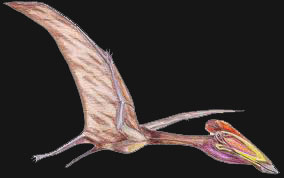 In the eighties another Paleontologist from Russia named Lev Nesov found that there is already a creature in the name Titanopteryx philadelphiae and so, in the year 1987, he renamed the creature as Arambourgiania to honor the first researcher Camille Arambourg. Even though, the name was changed, the pterosaur was informally called by the old name itself.
In the eighties another Paleontologist from Russia named Lev Nesov found that there is already a creature in the name Titanopteryx philadelphiae and so, in the year 1987, he renamed the creature as Arambourgiania to honor the first researcher Camille Arambourg. Even though, the name was changed, the pterosaur was informally called by the old name itself.
Bakonydraco
 From the fossils it was found that the lower jaw of Bakonydraco was toothless and half of the mandible was fused of its total length, which formed a pointed section expanded vertically and also compresses side-to-side, it was also long, so it would have looked somewhat arrowhead or spearhead shape from the side view. This expansion is known to have occurred both on the top surface and on the lower edge, where the most acute point match up with a transverse ridge, which divides the straight back half.
From the fossils it was found that the lower jaw of Bakonydraco was toothless and half of the mandible was fused of its total length, which formed a pointed section expanded vertically and also compresses side-to-side, it was also long, so it would have looked somewhat arrowhead or spearhead shape from the side view. This expansion is known to have occurred both on the top surface and on the lower edge, where the most acute point match up with a transverse ridge, which divides the straight back half.
Caulkicephalus
 Caulkicephalus is a genus of pterosaur, belonging to the Pterodactyloidea, from the Isle of Wight off the coast of England.
Caulkicephalus is a genus of pterosaur, belonging to the Pterodactyloidea, from the Isle of Wight off the coast of England.
Dimorphodon
 Dimorphodon (meaning "two-form tooth") was a pterosaur with a 4 feet (1.2 m) long wingspan. It was not a dinosaur, but type of extinct, flying reptile. It had a huge head with deep, wide, toothed jaws resembling the beak of the modern-day puffin, a short neck, and a diamond-shaped flap of skin at the end of the long, pointed tail. Its disproportionately large head may have been for courtship rituals.
Dimorphodon (meaning "two-form tooth") was a pterosaur with a 4 feet (1.2 m) long wingspan. It was not a dinosaur, but type of extinct, flying reptile. It had a huge head with deep, wide, toothed jaws resembling the beak of the modern-day puffin, a short neck, and a diamond-shaped flap of skin at the end of the long, pointed tail. Its disproportionately large head may have been for courtship rituals.
Eudimorphodon
 Eudimorphodon was a pterosaur, not a dinosaur. This was a group of reptiles that had flying or gliding abilities.
Eudimorphodon was a pterosaur, not a dinosaur. This was a group of reptiles that had flying or gliding abilities.
Feilongus
 Feilongus is only one of a huge assortment of pterosaurs, feathered dinosaurs and prehistoric birds that have been recovered from China's Jehol fossil beds; it belonged to the same general group as the more well-known Pterodactylus and Ornithocheirus.
Feilongus is only one of a huge assortment of pterosaurs, feathered dinosaurs and prehistoric birds that have been recovered from China's Jehol fossil beds; it belonged to the same general group as the more well-known Pterodactylus and Ornithocheirus.
Hatzegopteryx
Hatzegopteryx is a species belonging to the family of azhdarchid pterosaur. The fossils of this creature were found in Transylvania. From the left humerus, skull fragments and other remains of Hatzegopteryx researchers found that it would have been a huge animal with a wingspan of about 40ft (i.e.) twelve meters.Jeholopterus
 The term Jeholopterus was derived from Greek and the meaning of the term is Jehol wing. The term is pronounced as Jay-hole-op-ter-us. This creature was known to have in the shores of the continent of Asia about 150 million years ago. In Asia, it was particularly known to have lived in the northeastern part of China in the Daohugou Beds.
The term Jeholopterus was derived from Greek and the meaning of the term is Jehol wing. The term is pronounced as Jay-hole-op-ter-us. This creature was known to have in the shores of the continent of Asia about 150 million years ago. In Asia, it was particularly known to have lived in the northeastern part of China in the Daohugou Beds.
Liaoningopterus
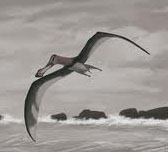 Liaoningopterus was named in 2003 by Wang Xiaolin and Zhou Zhimin.
Liaoningopterus was named in 2003 by Wang Xiaolin and Zhou Zhimin.
Lonchodectes
 Lonchodectes, the meaning of which is nothing but a 'lance biter' belonged to the genus of the Azhdarchoid pterosaur reined in the ancient parts of England during the Valanginian to great Turonian age. The species was tagged with Ornithocheirus until Dr. David Unwin finally came to his conclusion in the year 2000. Still there were contradictions among the scientists with the perfect genus of the lance biter, the sea gull like bird Lonchodectes.
Lonchodectes, the meaning of which is nothing but a 'lance biter' belonged to the genus of the Azhdarchoid pterosaur reined in the ancient parts of England during the Valanginian to great Turonian age. The species was tagged with Ornithocheirus until Dr. David Unwin finally came to his conclusion in the year 2000. Still there were contradictions among the scientists with the perfect genus of the lance biter, the sea gull like bird Lonchodectes.
Microraptor
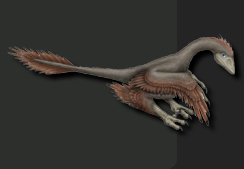 Microraptor fossils have been known to have impressions of feathers and wings.
Microraptor fossils have been known to have impressions of feathers and wings.
Nemicolopterus
Nemicolopterus belong to the Pterodactyloid Pterosaur genus. Until 2008 we were not associated with the name. It is assumed that the species frequented in Jehol Biota about 120 million years back. It was not a giant bird; just a small one having a wingspan of 10 inches.Nyctosaurus
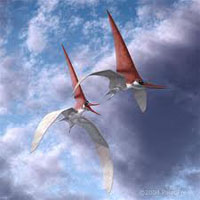 Nyctosaurus is an extraordinary pterosaur with an unusually large and elaborate cranial crest on top of its head. It is also the only (its closest relatives aside) pterosaur to have lost its clawed fingers, indicating that it must have spent the majority of its time in flight.
Nyctosaurus is an extraordinary pterosaur with an unusually large and elaborate cranial crest on top of its head. It is also the only (its closest relatives aside) pterosaur to have lost its clawed fingers, indicating that it must have spent the majority of its time in flight.
Ornithocheirus
 Long body, long neck. Greenish colour,
Long body, long neck. Greenish colour,
Pedopenna
 The Pedopenna was more of a bird than a dinosaur. It had feathers like the modern birds. Paleontologists have been debating if this dinosaur did, in fact, evolve completely into a bird.
The Pedopenna was more of a bird than a dinosaur. It had feathers like the modern birds. Paleontologists have been debating if this dinosaur did, in fact, evolve completely into a bird.
Pterodactylus
 Pterodactylus are not dinosaurs. They belong to a group called Pterosauria. This group consisted of about 100 fly reptiles that had a lot in common with birds of today.
Pterodactylus are not dinosaurs. They belong to a group called Pterosauria. This group consisted of about 100 fly reptiles that had a lot in common with birds of today.
Quetzalcoatlus
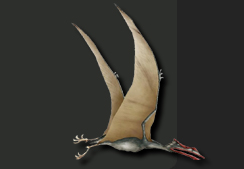 Quetzalcoatlus was a flying reptile and not a dinosaur. It belongs to a group called pterosaur.
Quetzalcoatlus was a flying reptile and not a dinosaur. It belongs to a group called pterosaur.
Zhejiangopterus
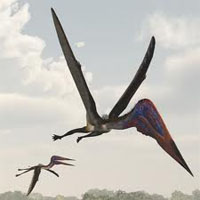 Zhejiangopterus is a genus of azhdarchid pterosaur known from one species, which lived in China during the late Cretaceous Period.
Zhejiangopterus is a genus of azhdarchid pterosaur known from one species, which lived in China during the late Cretaceous Period.
Extinct Pterosaurs
Click on any of the pictures or names above to learn specifically about that particular Pterosaur. The meaning of the term ‘Pterosaurs' is winged lizards. These flying reptiles hold a unique place in the history of the life in earth. In addition to insects these creatures were the first to successfully crowd the skies.
Pterosaurs were first discovered by a group of international researchers from the Geological Institute of Beijing in the country of China and the University of Leicester situated at the United Kingdom. This group was the first to show clear evidence of a controversial and unusual type of evolution.
Types of Pterosaurs:
Pterosaurs were also called as pterodactyl and they were known to have existed in the Mesozoic Era (i.e.) around 225 million years ago. The researchers found that Pterosaurs might have been of two different types, one type with short tail and the other type with long tail. They also found that the Pterosaurs with long tail would have been the first of its kind and later Pterosaurs would have born with shorter tail and some of these short tail Pterosaurs would have reached gigantic in size. Pterosaurs, which born in the later era would have been able to walk, but the primitive Pterosaurs with longer tail would not have been able to fly.
Researchers found that Pterosaurs would have got membranous wings and a bird like beak. Their wings may have been supported by a very long fourth number of each forelimb.
The researchers found that there would have been a long gap between the period of long tailed Pterosaurs and short tailed Pterosaurs. This gap is identified in the time of Charles Darwin. The new Pterosaurs born after Darwin's period were named Christened Darwinopterus and the meaning of the term is Darwin's wing. This name was given to these Pterosaurs to honor Darwin on this 200th birth anniversary. The fossils of these later Pterosaurs were found in more than 20 numbers in the country of China. These researchers found that these late Pterosaurs would have lived 160 million years ago. It was found that these later Pterosaurs were around 10 million years older than the first bird species named Archaeopteryx.
The later Pterosaurs would have had rows of sharp pointed teeth, long jaws, and a flexible neck. From the fossils of the Pterosaurs, it was found that they would have been the size of a crow and they would have eaten contemporary flying creatures by catching and killing them.
Difference and similarities between earlier Pterosaurs and later Pterosaurs:
As said earlier, Pterosaurs of the later period differed from that of earlier period not only in their appearance, but also in their feeding habits. Normally researchers identified the eating habits of the different types of Pterosaurs on the basis of the shape and size of their jaws and on the basis of the analogous behavior found in modern birds. According to them, Pterosaurs with narrow and sharp beaks would have subsisted on fish while the other type of Pterosaurs would have subsisted by sucking the blood of dinosaurs much like a vampire bat. This eating habit theory was just an assumption made by the researchers on the basis of the fossils it has not been proved.
Even though researchers have found only certain similarities between the Pterosaurs of earlier period and later period, the main similarity between these two Pterosaurs is the warm-blooded metabolism.
Some creatures belonging to Pterosaurs genus:
Some of the flying reptiles coming under the category of Pterosaurs are given below:
• Dorygnathus – These Pterosaurs were known to have lived in Western Europe.
• Nemicolopterus – These Pterosaurs were known to have lived in China and the fossils of these Pterosaurs were discovered recently in the year 2008.
• Tapejara – These are colorful Pterosaurs known to have lived in South America.
• Tupuxuara – These are other colorful Pterosaurs and these are known to have been closely related to Tapejara.
• Ornithocheirus - These are one of the Pterosaurs known to have lived in the Cretaceous period.
• Sordes - These are Pterosaurs, which were in the size of a pigeon and these Pterosaurs were known to have lived in the late Jurassic period.
• Eudimorphodon - These Pterosaurs were known to have been existed around 200 million years ago in the country of Europe .
• Anurognathus - These Pterosaurs were one among the smallest and they were known to have lived in the pre-historic period.
• Zhejiangopterus - These were one among the giant Pterosaurs.
• Quetzalcoatlus - These were regarded as one of the largest creatures in the family of Pterosaurs.
Physiology of Pterosaurs:
The main feature that differentiated the Pterosaurs from the later dinosaurs that lived in land is that Pterosaurs had wide flaps of skin which was connected to an extended finger of each of its hand. Like modern birds, Pterosaurs were also differentiated by their vision, which was very much helpful for them for hunting purposes. According to researchers, Pterosaurs' brain would have got more advanced coordination centers as compared to other reptiles and this helped them to find their prey easily as compared to other aquatic or terrestrial reptiles.
External Appearance of Pterosaurs:
The Pterosaurs differed in size from a few inches to over 35-40 feet. Some type of Pterosaurs like Pteranodon had bony and light-weight crests on their head and these crests would have acted as rudder when they were flying. The wings of some Pterosaurs were covered by leathery membrane. They would have able to fly powerfully with the help of their strong wings, but some large Pterosaurs would have relied on breezes to help them in flying. This is because the larger Pterosaurs like Quetzalcoatlus had 11m wide wing.
Classification of Pterosaurs:
Pterosaurs were not dinosaurs, but they were reptiles. Even though Pterosaurs were not dinosaurs, some dinosaurs which came later to Pterosaurs were regarded as closely related to Pterosaurs. Pterosaurs were classified under animalia kingdom, Chodata phylum and vertebrata subphylum. They were classified under the superclass tetrapoda, class diapsids, and subclass archsauria. They were classified under the order pterosauria with two suborders Rhamphorhynchoidea and pterodactyloidea. Under each suborder they are classified into five different genus.

Index
Extinct Profiles
 Triassic Dinosaurs
Triassic Dinosaurs Jurassic Dinosaurs
Jurassic Dinosaurs Cretaceous Dinosaurs
Cretaceous Dinosaurs Pterosaurs
Pterosaurs Marine Reptiles
Marine Reptiles Dinosaur Extinction
Dinosaur Extinction